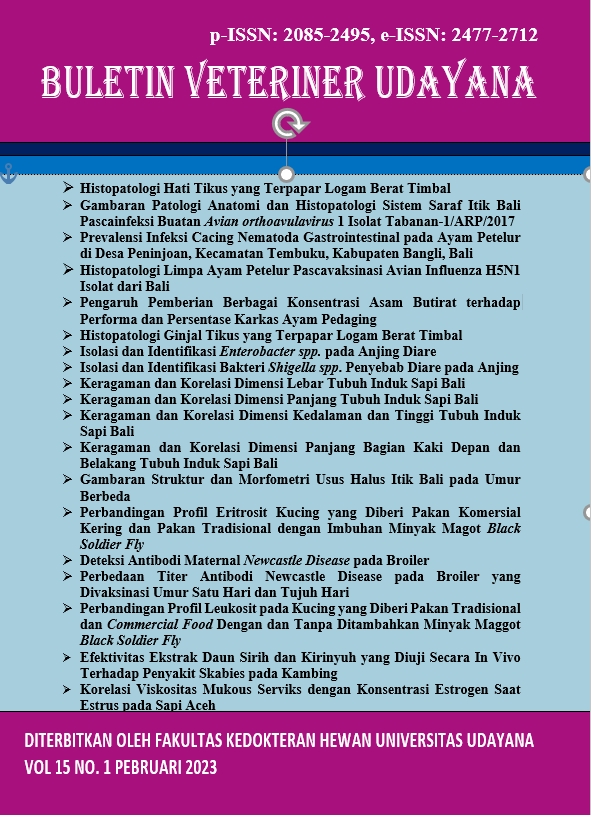ISOLATION AND IDENTIFICATION OF ENTEROBACTER SPP. IN DOG DIARRHEA
Abstract
This study aims to isolate and identify Enterobacter spp. from the digestive tract of dogs with diarrhea. Diarrhea is a digestive disease that commonly attacks dogs, one of which can be caused by Enterobacter spp. This study using 48 samples in the form of a dog with diarrhea rectal swabs from Denpasar and surrounding areas. The samples were isolated on Eosin Methylene Blue Agar, MacConkey, and Blood Agar media by streak method and then incubated for 24 hours at 37°C, then primary tests were carried out, namely gram staining, catalase test, and oxidase test, and identification tests were carried out on Triple media. Sugar Iron Agar, Simon Citrate Agar, Sulfide Indole Motility, Methyl Red Voges Proskauer, and sugar test. The results showed that two (4.16%) positive samples of Enterobacter spp. diarrhea in dogs. Therefore it can be concluded that Enterobacter spp. can be isolated and identified in the digestive tract of dogs with diarrhea. Howewer, it is necessary to carry out identification test for each Enterobacter species and more in-depth research on the pathogenicity of Enterobacter spp.
Downloads
References
Chandler, M. 2011. Solutions in veterinary practice: small animal gastroenterology. London. Elsevier. Pp 113.
Goodman RE, Pickett MJ. 1966. Delayed lactose fermentation by Enterobacteriaceae. J. Bacteriol. 92 (2): 318-327.
Hartel H, Nikunen S, Neuvonen E, Tanskanen R, Kivela S, Aho P, Soveri T, Saloniem H. 2004. Viraland bacterial pathogens in bovine respiratory disease in Finland. Acta Vet. Scandinavica. 45: 193-200.
Hubbard, Skelly K, McKelvie BJ, Wood JLN. 2007. Risk of vomiting and diarrhoea in dogs. Vet. Rec. 161(22): 755-757.
Indarjulianto S, Widyarini S, Suparta GB, Nururrozi A, Yanuartono, Raharjo S, Sitompul YY, Tidariani I, Ekawati A, Nalasukma MC. 2021. Pemilihan antibiotika pada anjing diare yang terinfeksi Escherichia coli. J. Sains Vet. 39(1): 47-54
Jawetz E, Melnick JL, Adelberg EA. 200. Mikrobiologi kedokteran. EGC Press. Jakarta.
Kakang DM, Batan IW, Nindhia TS. 2017. Pemeliharaan anjing oleh masyarakat kota Denpasar yang berkaitan dengan faktor risiko rabies. Indon. Med. Vet. 6(2): 138-152.
Prescott HK. 2002. Laboratory exercise in microbiology. The Mc Gram Hill Companies. New York. Pp. 126-139.
Public Health England (PHE). 2015. Identification of Enterobacteriaceae. UK standards for microbiology investigations (Smis).
Puspitasari AI. 2021. Penggunaan media agar darah manusia untuk pertumbuhan bakteri golongan beta hemolisa. Tesis. Surabaya: Universitas Nahdlatul Ulama Surabaya.
Riga PN, Buntuan V, Rares F. 2015. Isolasi dan identifikasi bakteri aerob yang dapat menyebabkan infeksi nosokomial di ruangan instalasi gizi Blu Rsup Prof. Dr. R. D. Kandou Manado. J. e-Biomedik (eBm). 3(1): 227-235.
Saputra CFL. 2016. Implementasi konsep wild into coziness pada perancangan interior dog daycare center di Surabaya. J. Intra. 4(2): 423-434
Suarnata IW, Suarjana IGK, Rompis ALT. 2018. Enterobacter sp. pada sapi Bali menurut geografis dan tingkat kedewasaan serta pola kepekaannya terhadap antibiotika. Bul. Vet. Udayana. 10(2): 154-161.
Wahyuni RM, Sayuti A, Abrar M, Erina, Hasan M, Zainuddin. 2018. Isolasi dan identifikasi bakteri enterik patogen pada badak Sumatera (Dicerorhinus Sumatrensis) di Suaka Rhino Sumatera (Srs), Taman Nasional Way Kambas (Tnwk), Lampung. JIMVET. 4(2): 474-487.





